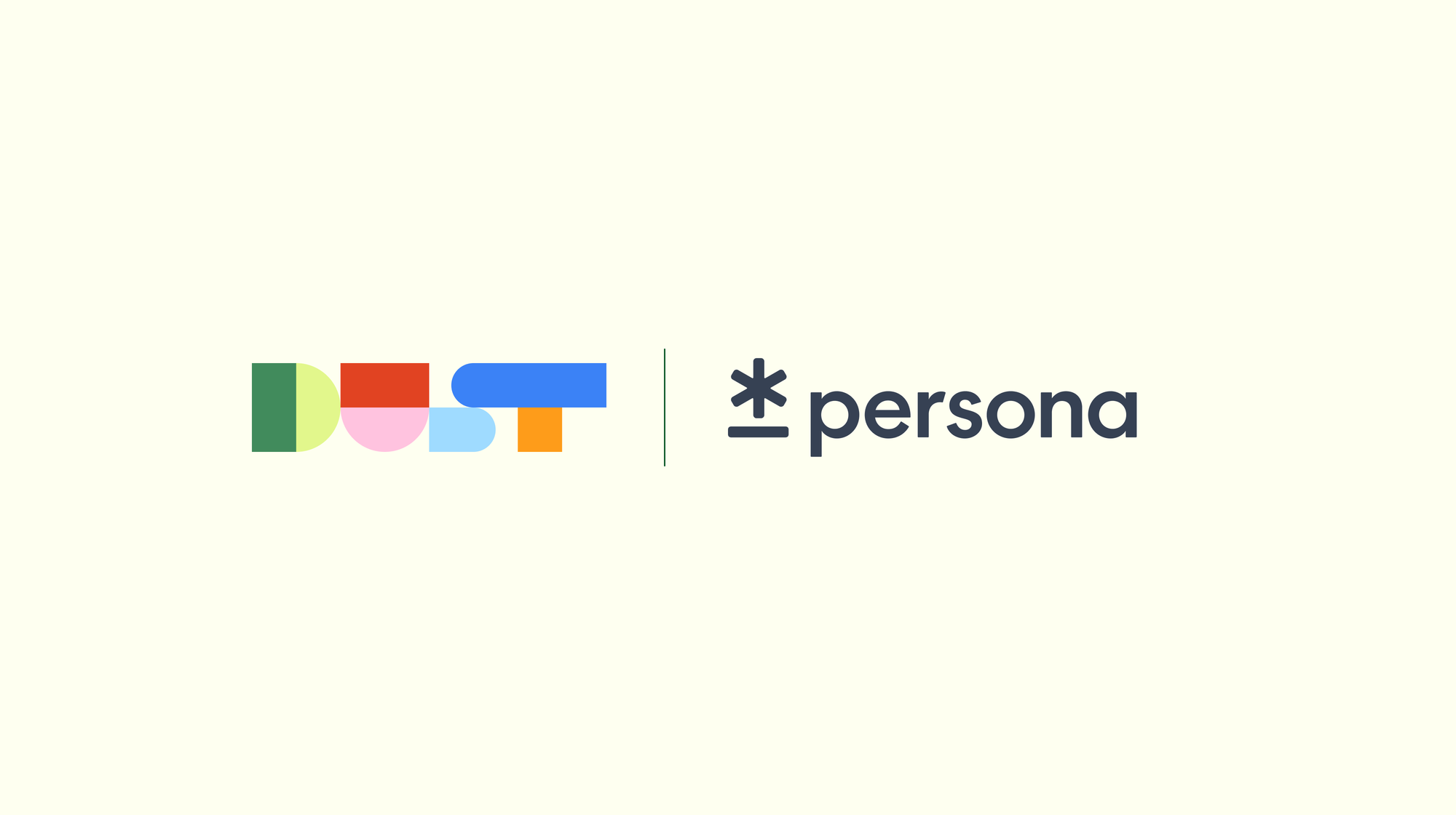How Persona Hit 80% AI Agent Adoption with Dust

As Persona scaled, engineers were drowning in questions, sales reps in RFPs, and solutions engineers in internal document creation. Dust’s PersonaEngineer agent became the wedge solution to unblock the organization.
Since launching in 2018, Persona has been at the forefront of identity verification. Now, with a $200 million Series D and a $2 billion valuation locked in, the company is stepping into its next phase of growth.
That next chapter is being shaped by AI. With AI changing the way everyone works, transacts, and communicates, identity has become a critical foundational layer for every organization. And the shift isn’t only happening outside the company. Inside Persona, AI is also transforming how teams get work done.
We sat down with Michael Yang, AI Operations Manager, to hear how Dust became the spark for that transformation and quickly grew into a company-wide tool now used by more than 80% of employees.
The challenge: Breaking down knowledge bottlenecks
Every fast-growing startup hits an inflection point. A moment when the processes that once kept things humming begin to buckle under the pace of growth. At Persona, that tipping point manifested as a series of knowledge bottlenecks.
As Michael explains: “It felt like we had information everywhere but no good way to get to it quickly. People were getting stuck on the same questions over and over again, and it was slowing everyone down.”
He points to three areas where the breakdown was most visible.
1. #ask-engineers
The #ask-engineers channel at Persona was created as a central space for technical questions. On any given day, a flood of requests rolled in: account executives checking on pending features, customer success managers reporting unexpected bugs, and solutions engineers asking about complex product capabilities. The volume was relentless. “It was basically a firehose,” Michael says. “Every question was fair game, which made sense, but it meant engineers were constantly pulled out of focus time just to keep up.” What had been designed to streamline communication ended up creating constant interruptions.
2. Requests for proposals (RFPs)
Sales and compliance teams were under pressure to respond to a steady stream of lengthy RFPs, each one filled with hundreds of detailed questions about security and privacy. The material they needed already existed in past submissions and documentation, but the process of reusing it was slow and manual.
“Every other week, we were cranking out massive RFPs with hundreds of questions,” Michael recalls. “We had tons of past material and documentation, but no easy way to leverage them. People were wasting hours looking for the right information.” Repetition became the norm: digging through old files, copy-pasting, rewording, and checking for accuracy. This left little time for higher-value work.
3. Internal customer documents
Depending on a prospect’s goals, solutions engineers are tasked with creating Solution Requirement Documents (SRDs) that define the scope of an engagement, including the precise requirements, success criteria, and more. Before Dust, the process was time-consuming and painful: solutions engineers had to review multiple meeting notes and call transcripts to write a formal document, following Persona’s internal template.
“Solutions engineers’ time is very precious. At any given moment, they’re handling multiple customer projects with impending deadlines and being pulled into new ones. Writing good SRDs is critical for many reasons, but it was taking away time for them to actually implement these solutions,” Michael says.
The opportunity: Unlocking viral organic growth
Persona’s co-founder and CTO, Charles Yeh, decided it was time to move beyond piecemeal fixes and experiment with something new. He signed up for Dust in March 2025 and used the #ask-engineers Slack channel as a testbed. Persona’s first experiment with Dust was a v0 system made up of several small, specialized agents, strung together with Zapier. For example, there was a FeatureRequestHistory agent that checked Jira for past requests, a SolutionsHistory agent that pulled answers from SOP docs, and a VerificationChecksExpert agent that handled verification-related queries.
It worked, but only up to a point. The system was complex and brittle, with multiple agents chained together to handle narrow tasks. “It still relied on engineers to self-triage,” Michael explains. “You’d have to check the thread, see if it was yours, or just jump in because no one else had yet.” The setup provided context, but it didn’t ease the firehose of questions engineers faced every day.
A weekend hack
The turning point came when Persona engineer Lewis Chung decided to run an experiment. Over a single weekend, he built a new Dust agent called PersonaEngineer. Unlike the v0 system, PersonaEngineer didn’t just dump every knowledge source into one agent. Instead, Lewis built it with specialized sub-agents, with each one focused on a specific domain. For example:
- DDDEngineer for GitHub codebases
- InfrastructureEngineer for production changes and incidents
- DataQueryExpert for data warehouses
- PersonaHelpCenter for help center and technical documentation
- PersonaGlossary for internal terminologies
- PeopleNerd for the employee directory
These sub-agents were orchestrated by a general reasoning layer (PersonaEngineer itself), which routed questions to the right place and stitched responses together. After a few days of tweaking, Lewis invited a few people across the company to test it out in a Slack channel. Then those initial testers invited even more people.
“People just started piling in,” Michael says. “It was never officially mandated or announced. They could just see what other people were asking and the impressive answers it generated, whether it was about specific product features or complex database queries. It was entirely organic. The channel grew to 200 people almost immediately, and usage kept snowballing.”
What began as a side project quickly became a sensation. It wasn’t long before PersonaEngineer was deployed to answer questions in the #ask-engineers channel and became the company’s wedge for AI adoption.
The ripple effect
The more people used PersonaEngineer, the faster it spread. In Slack, teams across the entire company saw what it could do in real time. Fraud analysts used the Dust agent to generate complex SQL queries, and engineers tapped it for instant incident context.
That visibility changed the dynamic almost overnight. “People saw PersonaEngineer in Slack, tried it for themselves, and invited their teammates to try it out. Then some went on to copy the agent to tune it to their specific needs, or build their own agents from scratch,” Michael recalls. “That’s when adoption exploded.”
A thousand flowers
The visibility of Dust in Slack lowered the barrier to experimentation. Subject-matter experts began publishing their own niche, specialized agents for their teams. Some were simple, others were more sophisticated, but together they created momentum.
“We don’t expect every agent to be perfect,” Michael explains. “Our philosophy is: let a thousand flowers bloom. Even if an agent is rough, it’s educational. And once people see how easy it is to build agents on Dust, better versions come quickly.” That philosophy wasn’t just about volume. By making it easy for anyone to try building an agent, Persona gave employees a way to learn AI by doing.
“Before your company becomes AI-enabled, your employees first have to become AI-native,” Michael explains. Unlike general-purpose tools, which often feel limited for non-technical users, Dust lets everyone connect their own knowledge and workflows to AI. Out of that experimentation grew a grassroots builder community. For every twenty people who tried building an agent, one or two emerged as real experts. Enough that now every department has its own go-to builder. In total, nearly 300 agents (published and unpublished) have sprung up across Persona. Most aren’t polished and some get deprecated, but that’s by design. “Dust didn’t just give us a tool—it gave us a playground,” Michael says. “And that’s why it spread so successfully.”
The results: Faster work, fewer distractions
The most visible signal of Dust’s impact at Persona is adoption. Within six months of the launch of PersonaEngineer, adoption of specialized agents skyrocketed to more than 80% of the employee base. Specifically, out of 13 departments, 11 now have active users. And in Persona’s three largest departments, usage is even higher: 85% in Sales, 85% in Post-Sales, and 50% in Engineering.

Beyond adoption, the time savings have been substantial.
Sales teams who once spent days pulling together long RFP responses now generate accurate answers in a fraction of the time by running them through RFPNerd, a Dust agent connected to all previous RFPs and latest company information.
Fraud analysts who used to spend hours on complex SQL queries can now finish the same work in under 30 minutes.
Solutions engineers have SRDNerd, which can automatically generate SRDs from call transcripts (and asks PersonaEngineer to help), allowing them to reclaim the hours that used to be lost to manual effort.
According to Patrick Hall, Product Architect at Persona:
"Dust is pretty dang powerful and could be not just a 10xer, but a 100xer if we harness it right."
The #ask-engineers Slack channel also became significantly more manageable. Instead of pulling engineers out of focus time with constant pings, Dust now provides context and answers directly in Slack, cutting down on noise and interruptions.
Dust also delivered an unexpected benefit: the beginnings of a built-in feedback mechanism. At first, Michael’s team manually scraped automated responses from Slack and reviewed them for quality and relevance. The process was labor-intensive, and the first batch involved more than 300 responses. But it highlighted where documentation and training needed strengthening.
More recently, Dust added feedback capture directly inside Slack, giving employees an easy way to flag when an answer is off. While still early, that signal has become a valuable data point to spot gaps and improve the agent over time.
Looking ahead
Persona continues to have big plans for Dust. The next agent currently being tested is PersonaSales, a general-purpose agent designed to centralize everything the sales team needs—from call preparation to competitive analysis and more. The long-term vision is that every department will have its own go-to agent to automate tasks and answer questions, all connected by a common backbone in Dust.
According to Michael, Dust isn’t just driving efficiency for existing tasks. It’s enabling people to think about entirely new kinds of tasks that were impossible to imagine before Dust. “Our product team now analyzes every call to catalog new use cases and feature requests, our security team scans every file for vulnerabilities, and our legal team now wants to review thousands of contracts,” he says.
For Michael, the most important shift isn’t just the tools themselves, but the collective mindset of the Persona team. “People aren’t asking, ‘Can we use AI?’ anymore,” he says. “They’re asking, ‘What else can we build with it?’ That’s the real shift.”
With Dust as its foundation, Persona has turned AI from an experiment into an engine for scale to power the company’s next chapter of growth.

